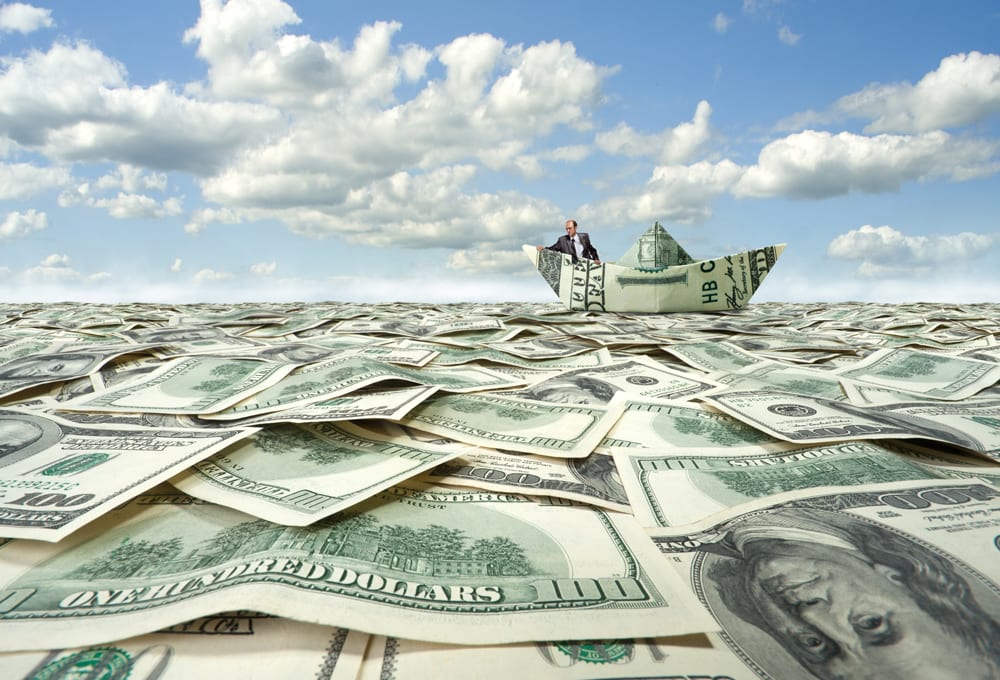How Does the Fed Influence the Stock Market? Like This…
Dear Readers,
Bubble. This has now become the word of focus in financial articles.
The S&P and the Dow has given up some gains after reaching record highs. Yet, we’ve seen this before – almost too many times over the past years; record highs, pullbacks, record highs, pullbacks.
The question is no longer about what real investor sentiment is, nor the fundamentals of stock, but rather what the central banks will do (just as is the case with gold.)
How much more will the banks and the Fed pump into the stock market to keep it afloat?
For years I have talked about how banks directly intervene in the bond market and secretly* manipulate equity prices through many sources including High Frequency Trading and high pressure lending.
*I say secretly because it’s against Fed and other bank policies to intervene in such matters.
The involvement of central banks has pushed equity prices to new historical highs all around the world.
But unlike the Fed, Japan’s central bank has had no problem directly buying equities, generally in the form of index ETF’s and REITs.
As I have emphasized many times before: Never make short-term bets against an entity that can print unlimited amounts of money. Unless you’re short the currency, that is…
Just this week, Bloomberg revealed that the Bank of Japan (BOJ) is now preparing once again to buy exchange-traded funds based on the JPX-Nikkei Index 400* as an “option to boost the impact of unprecedented easing and encourage companies to deploy cash for investment.”
*Note: The Nikkei 225 is comprised of the top 225 companies public companies in Japan; it is essentially Japan’s Dow Jones. The Nikkei 400 is comprised of the top 400 companies in Japan. In other words, the BOJ will be investing in even higher risk companies.
Recall Japan’s massive and ridiculous amount of stimulus to spur inflation to at least 2% – a difficult feat considering that the country has been in a deflationary state for most of the last 20 years.
In May, Japan announced that the nationwide consumer inflation rate accelerated to 3.7 percent in May from 3.4 percent in April, the fastest rise in 30 years.
This was expected with the record amount of stimulus launched last year.
However, core inflation – the BOJ’s preferred gauge – is expected to slow back to around 1%.
That means Japanese consumers are now forced to pay more for things as their currency continues to be devalued, while wages have yet to increase. This will once again lead to a slow-down in real economic growth.
The only way for the citizens of Japan to keep up is to take on more risk and invest in the stock market (precisely as the BOJ wants them to do.)
The reality is simple: Japan’s central bank will have no choice but to print more money to meet its target of 2%. That means we’ll likely see further purchases of stock to boost the market as well as other forms of stimulus.
So while many financial journalists continue to talk about bubbles (one which I agree is happening), it may not be ready to pop just yet.
In March of last year, I told readers to front-run the BOJ and borrow yen to buy Japanese stocks.
The Nikkei, despite a pullback earlier this year, is still up over 20%.
Perhaps its time to front-run the BOJ again.
This is Where the Money is Going
Japan isn’t the only country that has influenced the stock market in order to prop up prices. The U.S. has done the same, only it hasn’t been as open about it.
Since Fed policy dictates that it cannot directly buy stocks, the Fed has found other ways to encourage people to take risks.
I have talked about these strategies many times before.
One of these strategies is to force banks to lend.
The problem, however, is that its difficult for banks to lend to unqualified borrowers. And since the majority of Americans have been terribly affected by the economic crisis, many of them don’t meet the requirements for borrowing.
With so much stimulus, where has all the money gone?
To the people who meet the requirements: big corporations with cash.
Remember a while back when I talked about the record amount of cash hoarding by big corporations and how they weren’t using it for capital investments (hiring, infrastructure, etc.) because the economy didn’t warrant such actions?
So what do you do when you have so much cash, but nowhere to deploy it?
Invest in the stock market…simple!
Since spending didn’t make sense for these corporations, as the economy truly didn’t warrant further hiring or sales, these companies decided to buy a record amount of their own stock with their cash pile.
When a company issues a share buyback, the amount of outstanding shares in a company decreases. This leads to a higher Earnings Per Share (EPS), which makes the stock look much more attractive. This, of course, leads to higher share prices.
While this is great for shareholders, its bad for the economy as the cash is no longer put to use to hire new employees or grow the company.
Share buybacks continue at record pace and I expect billions of dollars in transactions over the next few months alone.
But there’s even more to this story than what the face value suggests.
While the headlines tell us of record cash holdings at corporations (giving the illusion sales are great), what they don’t tell us is that US corporate cash holdings is at the lowest level relative to corporate debt.
That’s because banks – as I just mentioned – have had to lend record amounts of money out. And since many consumers no longer qualify to buy houses or take out other loans, the majority of this lending has gone to big corporations.
“Total outstanding commercial and industrial (C & I) lending, which runs the gamut of loans to sectors from energy to healthcare and excludes consumer or real estate loans, rose to a record $1.7tn in May from a post-crisis trough of $1.2tn nearly four years ago, according to data from the Federal Reserve Bank of St Louis.
For the top 25 US commercial banks by assets, C & I lending grew by 10.5 per cent in the quarter to June 25 from the previous quarter, according to annualised weekly data from the Federal Reserve.
This type of lending is an important source of business for the largest US banks, representing about a fifth of all loans made by the likes of Bank of America, JPMorgan Chase and Wells Fargo, according to Citigroup research.”
Here’s the punchline:
“Much of the corporate lending is going to fund payouts to shareholders, finance acquisitions and fuel the domestic energy boom, bankers say, rather than to support companies’ organic growth.
…A second corporate banking executive at a large regional lender said: “The larger part of the usage in the market right now are loan refinancings where companies are paying dividends back out.” He added: “They’re requesting increased loans or usage under a lien in order to pay a dividend or equity holders of a company. Traditionally banks have been very cautious of that.”
Charles Peabody, a bank analyst at Portales Partners in New York, has warned that while it is hard to extrapolate what is driving commercial and industrial lending, if it is to fund acquisitions or share buybacks it may not indicate a strengthening economy.”
This mean that companies aren’t borrowing money to hire new workers, they’re borrowing record amounts of money just to give away to shareholders.
And of course, as I mentioned last week, the majority of these shareholders are the richest 5% of Americans who own directly 82% of U.S. publicly traded stocks.
Go figure.
Note: I had written a lengthy article on the battle between the East and West this week with a focus on the Dollar. But since it’s the World Cup finals today, I have decided to hold it for next week. I am sure most of you are too busy to read this week’s letter anyway…
Until next week,
Ivan Lo













Most small businesses with cash are better of with stock market rather than reinvesting in business. Currently you have to have one foot on the gas and one foot on the break. Keep the party swinging the music playing while the money keeps printing.
Another awesome article…
We enjoyed the article-thank you, and BTW, we always make the time to read your notes ASAP.
Another note of praise…your massages are always worth reading and
thought provoking. This week’s left me wondering what I could do
about it, although it nudged me toward selling a fund with a heavy
load of banks.
I also made me wonder why you questioned this theme as being impor-
tant. No apology needed.
Thanks very much for sharing your insights!
Bill Macy
Thank you!